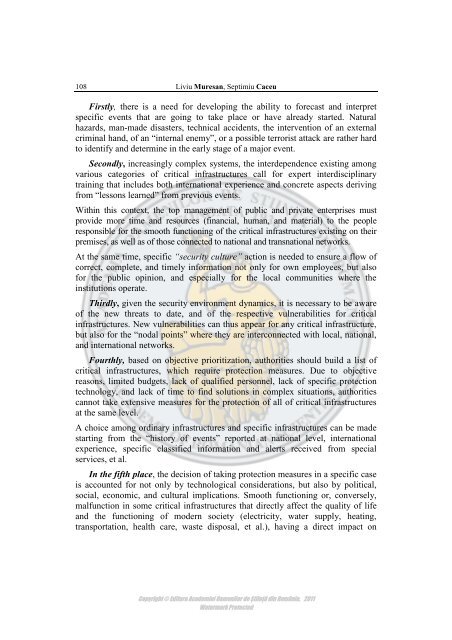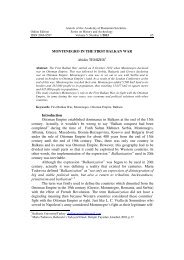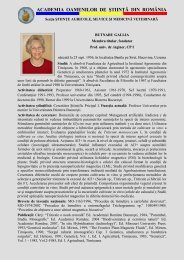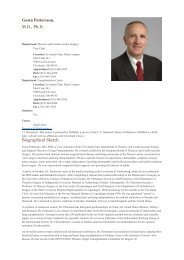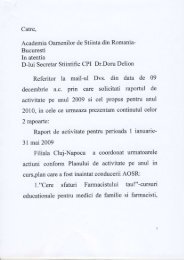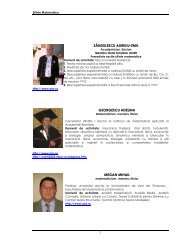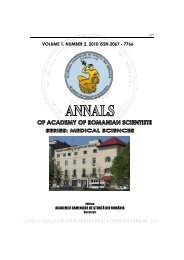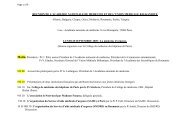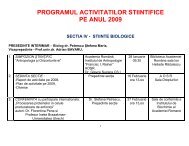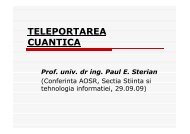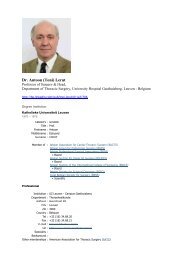Volume 3 nr 1 / 2011 - Academia Oamenilor de Stiinta din Romania
Volume 3 nr 1 / 2011 - Academia Oamenilor de Stiinta din Romania
Volume 3 nr 1 / 2011 - Academia Oamenilor de Stiinta din Romania
- No tags were found...
You also want an ePaper? Increase the reach of your titles
YUMPU automatically turns print PDFs into web optimized ePapers that Google loves.
108 Liviu Muresan, Septimiu CaceuFirstly, there is a need for <strong>de</strong>veloping the ability to forecast and interpretspecific events that are going to take place or have already started. Naturalhazards, man-ma<strong>de</strong> disasters, technical acci<strong>de</strong>nts, the intervention of an externalcriminal hand, of an “internal enemy”, or a possible terrorist attack are rather hardto i<strong>de</strong>ntify and <strong>de</strong>termine in the early stage of a major event.Secondly, increasingly complex systems, the inter<strong>de</strong>pen<strong>de</strong>nce existing amongvarious categories of critical infrastructures call for expert interdisciplinarytraining that inclu<strong>de</strong>s both international experience and concrete aspects <strong>de</strong>rivingfrom “lessons learned” from previous events.Within this context, the top management of public and private enterprises mustprovi<strong>de</strong> more time and resources (financial, human, and material) to the peopleresponsible for the smooth functioning of the critical infrastructures existing on theirpremises, as well as of those connected to national and transnational networks.At the same time, specific “security culture” action is nee<strong>de</strong>d to ensure a flow ofcorrect, complete, and timely information not only for own employees, but alsofor the public opinion, and especially for the local communities where theinstitutions operate.Thirdly, given the security environment dynamics, it is necessary to be awareof the new threats to date, and of the respective vulnerabilities for criticalinfrastructures. New vulnerabilities can thus appear for any critical infrastructure,but also for the “nodal points” where they are interconnected with local, national,and international networks.Fourthly, based on objective prioritization, authorities should build a list ofcritical infrastructures, which require protection measures. Due to objectivereasons, limited budgets, lack of qualified personnel, lack of specific protectiontechnology, and lack of time to find solutions in complex situations, authoritiescannot take extensive measures for the protection of all of critical infrastructuresat the same level.A choice among or<strong>din</strong>ary infrastructures and specific infrastructures can be ma<strong>de</strong>starting from the “history of events” reported at national level, internationalexperience, specific classified information and alerts received from specialservices, et al.In the fifth place, the <strong>de</strong>cision of taking protection measures in a specific caseis accounted for not only by technological consi<strong>de</strong>rations, but also by political,social, economic, and cultural implications. Smooth functioning or, conversely,malfunction in some critical infrastructures that directly affect the quality of lifeand the functioning of mo<strong>de</strong>rn society (electricity, water supply, heating,transportation, health care, waste disposal, et al.), having a direct impact onCopyright © Editura Aca<strong>de</strong>miei <strong>Oamenilor</strong> <strong>de</strong> Știință <strong>din</strong> România, <strong>2011</strong>Watermark Protected


